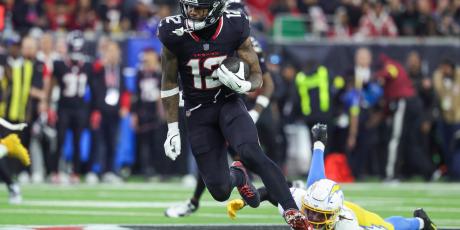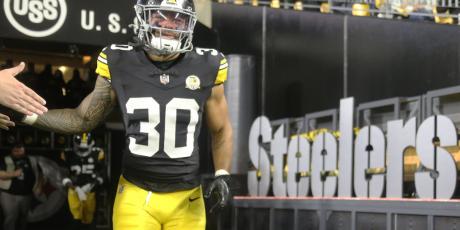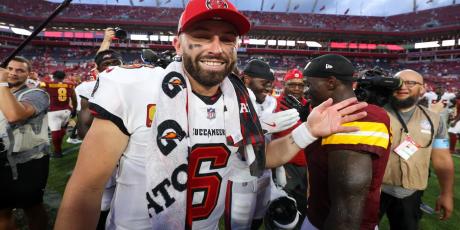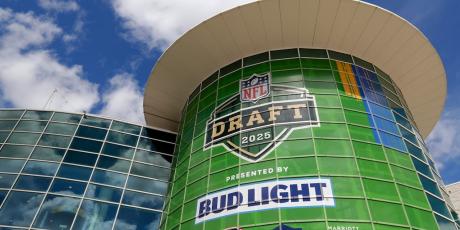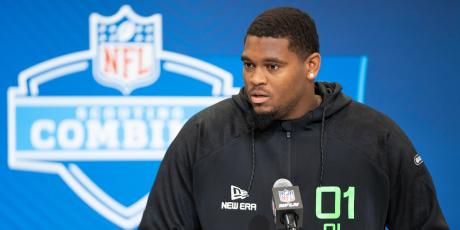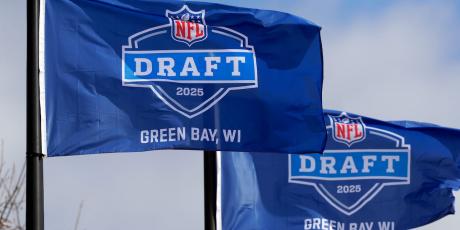An Intro to Best Ball Leagues: Structure, Rules & Basic Strategy

Best ball has quickly become one of the most talked about and played forms of fantasy football. A few years ago, people seldom talked about it, but now it is seemingly everpresent with copious content, takes, and ways to play. What exactly is best ball and why has it risen so quickly?
Best ball allows users to draft teams with no further time commitment. Once your draft is complete, the team is set.
While best ball is not entirely new, the market of extensive and diverse best ball tournaments certainly is new. Without further management, the strategy shifts, and drafters' team limits expand exponentially.
Best Ball Resources: How Draft Date Impacts Best Ball Leagues | Anatomy of a Better in Best Ball WR | ADP Risers & Fallers: June | How to Approach Underdog 3-Team Best Ball Drafts | NFL Schedule Release: Weeks 15-17 Targets for Best Ball Tournaments | How to Manage Rookies in 2024 Best Ball Drafts |
Depending on your desired level of investment, best ball can represent the lowest level of investment or the highest. People no longer need to set lineups, patrol the waiver wire, weigh trade offers, or make any other decisions after the final selection is made in the draft, removing the periodical work necessary to succeed and manage a typical redraft team. On the other hand, it allows users to increase the number of teams they draft exponentially. Some people have already drafted a few hundred teams and plan to complete over a thousand.
Why Play Best Ball
Every avid fantasy player grew up with their eyes on their season’s draft well before it occurred. Many opt to partake in numerous mock drafts to prepare and live out the most anticipated and exciting part of the fantasy season when every team is a monument to a drafter’s hope and vision. Given these common experiences, the appeal of best ball is evident to most avid fantasy players immediately. The opportunity to draft teams on demand can be quite alluring.
If you drafted whenever you wanted in other formats, the time commitment to managing those teams, evaluating trades, making sit-start decisions, and utilizing the waiver wire can become a chore. Even the most engaged players can miss a waiver wire run or be unavailable to make a lineup alteration after a last-minute scratch. Best ball removes these negative experiences while providing an immediate shot of dopamine when drafting.
The emergence of large field best ball tournaments also means you can win life-changing money. Multiple tournaments have prizes at or north of $1M. Putting your thoughts to the test for a few dollars with the possibility of turning it into astronomically more certainly entices numerous players. The odds of converting these small entry fees into top prizes is miniscule but being able to sweat the teams and tell yourself a story can make it a fun ride regardless. Stand-alone “sit and go” leagues are also available for people looking to grind smaller edges and less interested in the high degree of variance.
How is Best Ball Structured?
The most prevalent best ball sites mirror the draft setup of your redraft or seasonal leagues. You enter as one of 12 drafters taking turns selecting players around the league competing to draft the best team. Players take turns making picks as the draft snakes around.
The main differences commence once the NFL season initiates. Each week, you are given the maximum possible points for a lineup of the players you originally drafted. The majority of best ball teams drafted this year will be in tournaments and not stand-alone leagues. Stand-alone leagues reward the players with the most points after 17 weeks complete, Tournaments diverge from stand-alone leagues after Week 14 when the top two teams advance to the next round. All advancing teams are then randomized into new “pods”. At this point, it becomes a weekly tournament. Teams’ weekly scores are calculated before the highest-scoring one(s) advances to the next week. This process repeats till Week 17.
In Week 17, all remaining teams are grouped into one “pod”. Final places are determined based on the Week 17 results. This round contains the bulk of the prize money, so making it to this round, and performing well here, is imperative to success.
Each round you advance through, there is typically an associated payout. For example, in Underdog’s Best Ball Mania V, the top two scoring teams in Weeks 1-14 from each draft move to the next round and get paid their entry fee ($25) plus a bit more (+$10). Making it through each round can be very difficult. Accordingly, the payouts become progressively higher. Every finalist in Best Ball Mania gets $3,750 and has a chance at $1.5 Million.
Advance rates in each round can vary depending on the tournament.
Understand Your Objectives
Before entering, take a moment to ensure you understand the scoring and setup of the tournament you are eyeing. Different sites may have a different number of rounds as well. To no one’s surprise, these considerations significantly impact how you might want to approach the draft.
While it takes minimal effort to click into the rules section for any tournament, most people are more concerned with the thrill of drafting rather than the settings. This inclination and eagerness to draft is understandable; however, if the tournament uses season-long points total for payouts, PPR scoring, half-point PPR scoring, different roster formats, a unique advancement structure, or any other oddities, this could impact your choices in that given draft.
More importantly, take a moment to think about how this entry fits into your budget, and if you’re aiming to become a full-on grinder, throw a few entries in to get in on the fun, or as practice before your redraft league. There is no issue with any approach, but I would recommend adjustments to strategy depending on your goal.
If you’re doing a few drafts for fun and in place of traditional mock drafts, lean into player takes and stake claim to the players whose outlook you look most graciously upon. If you’re planning to draft a hundred teams, play in high-stakes leagues, or possibly both, I’d recommend potentially taking a moment of humility and reading additional articles on strategy. Much to all of our egos’ chagrin, in all likelihood, we do not have all the answers or the best takes. Be conscious of where you’re overriding average draft position (ADP) and attempt to avoid drafting teams that are too similar. This is not to say taking stands or being overweight players is inherently incorrect, but when as your investment increases, both in terms of dollars and time, being keenly aware should only heighten your ability to succeed.
Different Tournament Options
There are three main sites for best ball tournaments, each of which offers a flagship tournament.
Drafters
Drafters specializes in season-long total point tournaments. After the draft, the “pod” you drafted with becomes irrelevant, as you immediately compete against all other teams. Drafters tournaments are 20 rounds and use PPR scoring. In tournaments such as this, each week is equally important. Teams that skirt on by, then explode late in the season may be too far behind to catch up.
Notably, Drafters' flagship tournament did not fill the last couple of years so the rake percentage may differ from that listed below if it fails to fill again.
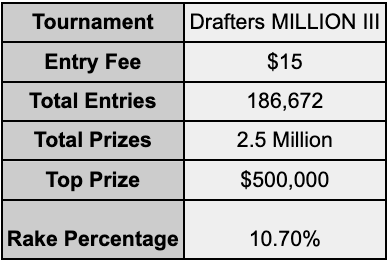

DraftKings
DraftKings’s best ball games use a different format, with a playoff format that was previously discussed. DraftKings tournaments are 20 rounds, use PPR scoring, and give three bonus points for reaching the milestones of 100 rushing yards, 100 receiving yards, and 300 passing yards. PPR scoring should heighten the importance of wide receivers, select running backs, and top-end tight ends.
DraftKings has increased its focus on its best ball product in the last couple of years, improving the interface and offerings.


*The above chart only shows the prizes for the finals
Underdog
Underdog offers a variety of contest types. The flagship Best Ball Mania V is a playoff format akin to those described earlier and that of DraftKings. The key difference between Underdog and other best ball sites is that the site utilizes traditional half-point PPR scoring and drafts are only 18 rounds. Unintuitively, Underdog has the most wide receiver heavy drafters. While it can be a strong move to scoop up value, you cannot avoid wide receiver for too long or your tournament winning hopes may be running on steam.
Underdog has by far the widest variety of contest types and structures. DraftKings’s contests are out more consistently, but Underdog offers contests periodically that fill in a short period. The tournaments are often referred to as “time-boxed”. As you will not compete with drafters later in the summer, taking some chances or looking for uncommon combinations of players can provide added upside. Each offers its wrinkles and methods for optimization. Ensure you consider any adjustments between them if you try out non-playoff format tournaments.


*The above chart only shows the prizes for the finals
Rewards
Each site above offers incentives to enter more volume in these tournaments. Drafters and DraftKings have offered rewards in the form of tickets for tournaments or bonus cash on the site. In the past, Underdog has run rakeback programs for best ball and daily contests.
Basic Strategy
Take a Beat
Always take a moment before entering a new tournament to ensure you understand the structure. If the tournament uses an atypical advancement structure or is a much smaller field, you may opt for more safety than upside swings.
As mentioned, different sites have different scoring formats, so when switching over consider these differences. Also, looking over the ADP can help you observe where you believe value lies. You may like the early quarterback prices a good bit, but if you actually like the late quarterback prices even more, passing on that early value may be your best move.
Be Conscious of Your Room
Draft rooms can vary significantly from one to the next. Go look at a Ship Chasing stream and compare one of those drafts to your normal draft. Paying attention to decisions your fellow drafters make can help you leverage value pockets that emerge in the draft.
If teams between you and your next pick all spent significant draft capital at quarterback and do not have teammates of one you are eyeing, try pushing him around till your next pick. Alternatively, if an auto-drafter or someone is taking multiple elite QBs, slide QBs up your board as they’ll be more scarce than in an average draft room.
ADP Value
Be conscious of ADP, or average draft position. Even after ADP, taking players you do not care for can feel wanting. Especially if you’re planning to draft dozens or hundreds of teams, showing respect to the market will likely improve your results. Yes, ideally we could just take the best plays, but eschewing value to harden your stance significantly increases your risk.
Fading a player should at least partially have to do with his cost. When that player falls 12 picks behind ADP, the proposition morphs. This is akin to taking a bet at +105 compared to -110. Many casual players will simply look at one sportsbook and not differentiate between prices. Over the long run, this price difference can be the gap between a profitable player and a break-even one or a losing player and a break-even one.
Positional Allocation
Best ball leagues closely resemble normal redraft leagues, but the differences in management make your draft capital even more paramount. Making up for stray picks is not an option after the draft, as you are locked into your team.
The importance of spending early draft capital on wide receivers remains one of the few common throughlines in best ball data to this point. Finding late hits at wide receiver can be much more difficult than other positions. At times, taking four or five wide receivers through seven rounds can seem like a prerequisite to succeeding. This, of course, is not entirely true, but taking less means you’re walking a very fine line.
One of the reasons this line becomes so difficult to walk is the potential temptation you may encounter later. After investing heavily in a position outside of wide receiver, you begin to restrict your flexibility moving forward. A good mantra to repeat while drafting is “quantity or quality, not both”. Wide receivers take up the most starting spots in best ball so you can afford to spend more on them, but this is still true at wide receiver.
Players often describe teams in terms of the count of players drafted at each position. A team with three quarterbacks, five running backs, eight wide receivers, and two tight ends would be referred to as a 3/5/8/2. As this sub-section notes, there are more intricacies to best ball teams than simple counts. The meshing of concepts to form teams that tell a story makes best ball exciting to play. The strategy and process can at times be as exciting as the results. Maybe that’s just because I haven’t actually had any big hits yet, though.
Aiming for Upside
Upside can be a frequent buzzword in best ball circles. To win large-field or even small-field tournaments, teams must hit on a considerable amount of upside and tail outcomes. For how consistently this topic is discussed identifying the spots for this “tournament-winning upside” remains extremely fickle.
There are a few spots that have shown consistent in the past. Rookies and late-round running backs have paid off much more than other options in recent years. Running backs far outproduce expectations when their primary limiting factor, opportunities, gets flipped on its head by a backfield mate’s injury. Rookies have the least data on them, and as such, have a wider band of outcomes than established veterans.
I urge you to practice caution about getting out over your skis on this though. The reason we cannot apply data one-to-one in best ball is that the environment we operate within is anything but stagnant. Rookies are more expensive than ever. Marvin Harrison Jr. frequently goes at the turn between Rounds 1 and 2.
Stack
In tournaments and even stand-alone leagues, the objective should always be to aim for first. Stacking teammates, particularly quarterbacks with pass catchers, condenses your bets and correlates your risk. Creating a wider range of distributions helps to improve your odds of finishing in the money.
When a quarterback throws a touchdown, a teammate invariably receives one. Setting yourself to benefit twice from one event outcome helps you harness the weekly variance inherent to football. Even taking pass catchers together or a running back and pass catcher can allow you to make a bet on the offense, as a whole, without the quarterback. If that team far exceeds expectations, you likely got two of the better picks this year.
Setting Expectations
Coming from a redraft background, it can be easy to get ahead of yourself. You may play with friends who are not keenly invested, and you may consistently make your championship game. Playing large field tournaments even the best players are underdogs to make the finals. In fact, in most years the best players will lose money. While you can put the odds in your favor, you cannot guarantee success.
For those interested in understanding expectations further, please reference the tournament expectation thread I maintain on my Twitter. I hope this serves to manage expectations. That said, if you have an edge, the math can begin to update dramatically.
Onward and Upward
Above all else, I hope you are more informed and interested in best ball now. There are plenty of ways to check out more about best ball. Streams are going almost 24/7 on YouTube at this point. Join the 4for4 Discord to review teams and chat about strategy. Check me out on Twitter @FeilNarley. I’ll post any article I write, any stream I appear on, and other thoughts on best ball there.
I will release an in-depth strategy guide for Underdog’s Best Ball Mania V in the coming days. Subscribe to 4for4 to see the whole article. I outline the basic strategy points I reviewed above in much more depth.


